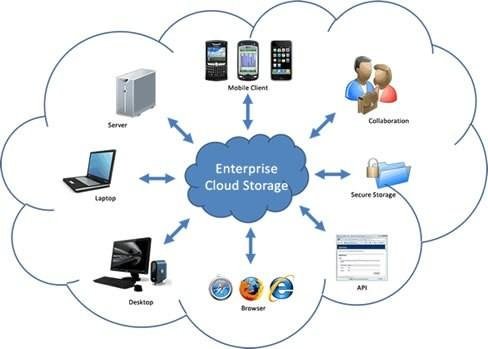
Cloud computing is a combination of the use of computer technology ('computing') and Internet-based ('cloud') development. Cloud (cloud) is a metaphor of the internet, as clouds are often depicted in computer network diagrams. As the cloud in the computer network diagram, cloud (cloud) in Cloud Computing is also an abstraction of the complex infrastructure that hid.
It is a computational method in which information technology-related capabilities are presented as a service, so that users can access it over the Internet ("in the cloud") without knowing what is inside, expert with it, or having control over the technological infrastructure who helped him. According to a 2008 paper published by IEEE Internet Computing "Cloud Computing is a paradigm in which information is permanently stored on servers on the internet and temporarily stored on client computers including desktops, tablet computers, notebooks, wall computers, handhelds, sensors, monitors and so on. "
Benefits of Cloud Computing
From the explanation of cloud computing above, there are many benefits that we can take from cloud computing, namely:
Scalability, ie with cloud computing we can increase our data storage capacity without having to buy additional equipment, such as hard drives etc. We simply add the capacity provided by cloud computing service providers.
Accessibility, ie we can access data whenever and wherever we are, as long as we are connected to the internet, making it easier for us to access data when important.
Security, that is, our data can be guaranteed by cloud computing service provider, so for IT-based company, data can be stored safely in cloud computing provider. It also reduces the costs required to secure corporate data.
Creative, ie the users can do / develop their creations or projects without having to send their project directly to the company, but the user can send it via cloud computing service provider.
Anxiety, when there is a natural disaster our data is stored safely in the cloud even though our hard drive or gadget is damaged.
Cloud Computing Example
Google Drive
is Google's online storage service. Google Drive launches on April 24, 2012. Actually Google Drive is a development of Google Docs. Google Drive delivers 5GB of storage to each user. Such capacity can be added by making payments or purchasing Storage. File storage in Google Drive can make it easier for file owners to access the file whenever and wherever using a desktop computer, laptop, tablet computer or smartphone. They can also be easily shared with others to share or collaborate in editing.
The History of Cloud Computing
In the 50s, Cloud Computing had a fundamental concept. When mainframe computers are available on a large scale in the world of education and the company can be accessed via a terminal computer called the Static Terminal. The terminal can only be used for communication but does not have internal processing capacity.
In order for the use of a relatively expensive mainframe to be efficient then develop the physical access of the computer from the division of CPU performance. This can eliminate periods of inactivity on the mainframae, allowing for a return on investment. Hinga mid-70s known as RJE remote process Entry Home Job that is associated with IBM and DEC Mainframe.
In the 60s, John McCarthy argued that "Calculations can someday be governed as public utilities." In Douglas Parkhill's book The Challenge of the Computer Utility shows the comparison of electrical industry and the use of electricity in the general public and government in the provision of cloud computing.
When Scientist Herb Grosch postulates that the whole world will operate on a body terminal supported by about 15 large data centers. Because the computer is very sophisticated, many companies and other entities provide their own computing capabilities over time and multiple organizations, such as GE GEISCO, IBM Corporation Bureau subsidiaries, Tymshare, National CSS, Data Dial, Bolt, and Beranek and Newman.
Year 1960
John McCarthy, Computational Expert and Artificial Intelligence from MIT. "Someday, computing will become a public infrastructure like electricity and telephony." [7] This is an idea that begins a form of computing that we know as Cloud Computing.
Year 1995
Larry Ellison, founder of the Oracle company. "Network Computing" This idea is actually quite unique and a bit insinuate Microsoft company at that time. In essence, we do not have to "plant" various software into the user's PC, from the operating system to other software. Enough with the connection with the server where will be provided an environment that covers the various needs of the user's PC.
In this era also discourse "Network Computing" quite popular. Many companies that raise this system include Sun Mycrosystem and Novell Netware. Unfortunately the quality of computer networks when it is still not adequate, users tend to choose the PC because it tends to be faster.
End of Era -90
Born the concept of ASP (Application Service Provider) which is marked by the emergence of data center processing company. This is a development on the quality of computer networks. Access for users is faster.
Year 2000
Marc Benioff, former vice president of Oracle company. "Salesforce.com" is a CRM software with SaaS base (Software as a Service). Unexpectedly this buzz received a great response. As a successor of Larry Ellison's vision, his boss. He has a mission that is "The End of Software".
2005 - Now
Cloud Computing is increasing in popularity, from system deployment, name usage, etc. Amazon.com with EC2 (Elastic Computer Cloud); Google with Google App. Engine; IBM with Blue Cord Initiative; etc. The cloud computing event is skyrocketing as time goes by. Now, a lot of usage of the computing system, coupled with the increasing quality of computer networks and the diversity of existing gadgets. Examples of applications are Evernote, Dropbox, Google Drive, Sky Drive, Youtube, Scribd, etc.